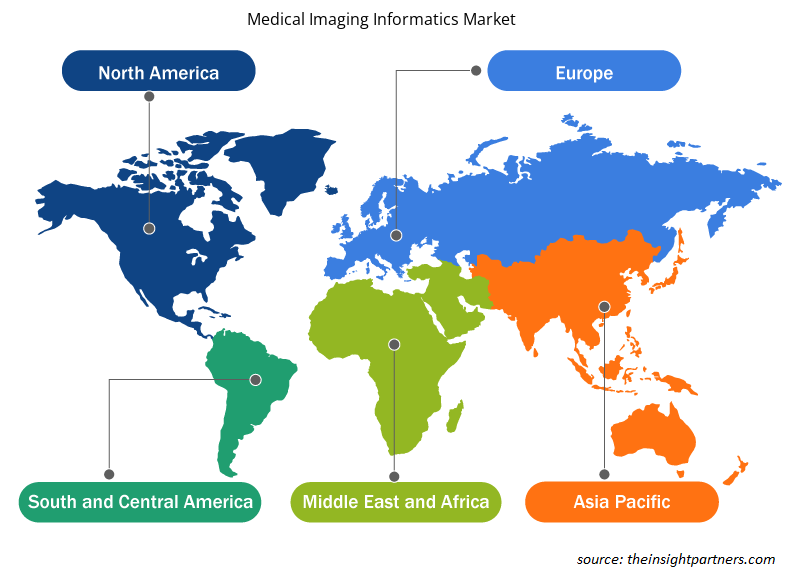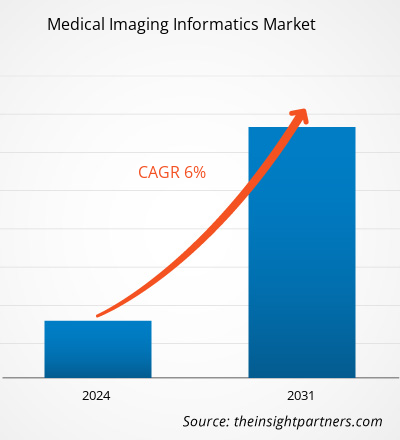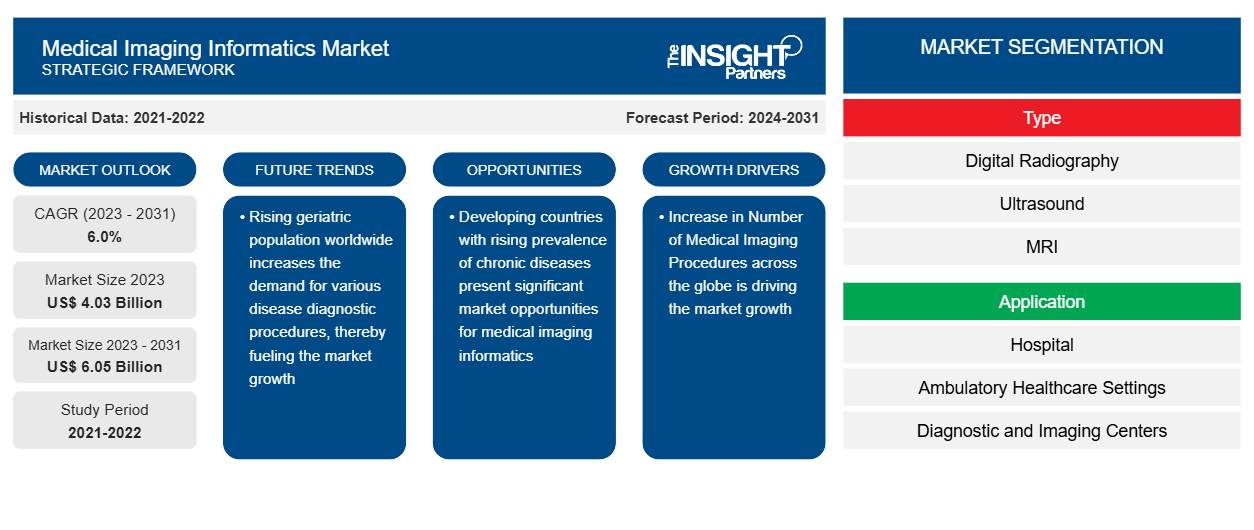Das Marktvolumen für medizinische Bildinformatik soll von 4,03 Milliarden US-Dollar im Jahr 2023 auf 6,05 Milliarden US-Dollar im Jahr 2031 anwachsen. Für den Zeitraum 2023–2031 wird eine durchschnittliche jährliche Wachstumsrate (CAGR) von 6,0 % erwartet.Die steigende Nachfrage nach KI- und Cloud-basierten Plattformen wird wahrscheinlich ein wichtiger Trend auf dem Markt bleiben.
Marktanalyse für medizinische Bildgebungsinformatik
Die wichtigsten Faktoren, die das Marktwachstum vorantreiben, sind die zunehmende Anzahl medizinischer Bildgebungsverfahren und der Anstieg der geriatrischen Bevölkerung. Darüber hinaus haben technologische Fortschritte in der medizinischen Bildgebungsinformatik im kommenden Prognosezeitraum Wachstumschancen für den Markt geschaffen.
Marktübersicht für medizinische Bildgebungsinformatik
Laut der klinischen Suchmaschine Radiology Key umfasst Bildinformatik den Einsatz von Informationstechnologie (IT), um effiziente, genaue und zuverlässige medizinische Bildgebungsdienste innerhalb eines Gesundheitsnetzwerks bereitzustellen. Die medizinische Bildinformatik, auch als Radiologieinformatik bezeichnet, ist für die Speicherung, Verwaltung und den Zugriff auf bildbezogene Informationen und Daten verantwortlich. Medizinische Bildgebung wird im Gesundheitssektor unter anderem in der Kardiologie, Geburtshilfe, Chirurgie und Gynäkologie eingesetzt. Neben der Zunahme der Diagnosen treibt die zunehmende Betonung der Früherkennung von Erkrankungen durch regionale und nationale Regierungen zur Senkung der Gesamtkosten im Gesundheitswesen die Zahl der Patienten in die Höhe, die sich weltweit einer Magnetresonanztomographie (MRT), Computertomographie (CT), Ultraschall- und Röntgenuntersuchung unterziehen, was den Bedarf an medizinischer Bildinformatik erhöht.
Passen Sie diesen Bericht Ihren Anforderungen an
Sie erhalten kostenlos individuelle Anpassungen an jedem Bericht, einschließlich Teilen dieses Berichts oder einer Analyse auf Länderebene, eines Excel-Datenpakets sowie tolle Angebote und Rabatte für Start-ups und Universitäten.
-
Holen Sie sich die wichtigsten Markttrends aus diesem Bericht.Dieses KOSTENLOSE Beispiel umfasst eine Datenanalyse von Markttrends bis hin zu Schätzungen und Prognosen.
Treiber und Chancen auf dem Markt für medizinische Bildinformatik
Anstieg der geriatrischen Bevölkerung
Großbritannien, Kanada, Japan, China, Indien und Südkorea sowie andere Volkswirtschaften haben ihre Gesundheitseinrichtungen und -dienste erheblich modernisiert. Infolgedessen ist die Lebenserwartung der Menschen in diesen Ländern gestiegen, was zu einem Wachstum ihrer geriatrischen Bevölkerungsbasis geführt hat. Laut Daten der WHO betrug die Zahl der Menschen im Alter von 60 Jahren und älter im Jahr 2019 1 Milliarde und dürfte bis 2030 auf 1,4 Milliarden und bis 2050 auf 2,1 Milliarden ansteigen. Die ältere Bevölkerung leidet hauptsächlich an verschiedenen chronischen Krankheiten wie Herz-Kreislauf- Erkrankungen (CVD), die auf strukturelle und funktionelle Veränderungen ihres Herz-Kreislauf-Systems zurückzuführen sind, die mit dem Altern einhergehen. Das Altern führt zur Versteifung von Herz und Blutgefäßen. Daher sind Herzrhythmusstörungen sowie koronare Herzkrankheit und Herzinsuffizienz häufige Risikofaktoren bei Menschen ab 75 Jahren. Im statistischen Update 2019 zu Herzkrankheiten und Schlaganfällen der American Heart Association (AAH) lag die Inzidenz von CVDs bei 77,2 % bei Männern und 78,2 % bei Frauen in der Altersgruppe von 60–79 Jahren. Darüber hinaus lag die Inzidenz von CVDs bei 89,3 % bei erwachsenen Männern und 91,8 % bei erwachsenen Frauen ab 80 Jahren. Somit erhöht die weltweit steigende geriatrische Bevölkerung die Nachfrage nach verschiedenen Krankheitsdiagnoseverfahren und medizinischer Bildgebungsinformatik und treibt das Marktwachstum an.
Dynamische Gesundheitslandschaften in China und Indien
Entwicklungsländer wie China und Indien bieten bedeutende Marktchancen für die medizinische Bildinformatik. Angesichts wachsender Bevölkerungen, steigender Gesundheitsausgaben und einer steigenden Prävalenz chronischer Krankheiten besteht in diesen Ländern eine wachsende Nachfrage nach fortschrittlichen medizinischen Bildgebungstechnologien. Die Einführung digitaler Bildgebungssysteme und Informatiklösungen nimmt in China und Indien zu, getrieben durch den Bedarf an effizientem Datenmanagement, verbesserter diagnostischer Genauigkeit und verbesserter Patientenversorgung. In China haben die Initiativen der Regierung zur Modernisierung der Gesundheitsinfrastruktur und Verbesserung des Zugangs zu hochwertigen Gesundheitsdiensten zu einer verstärkten Einführung von Lösungen für die medizinische Bildinformatik geführt. Die große Bevölkerung des Landes und der wachsende Gesundheitssektor bieten einen riesigen Markt für Anbieter, die fortschrittliche Bildinformatiktechnologien anbieten . In Indien treibt die wachsende Zahl von Gesundheitseinrichtungen, gepaart mit dem steigenden Bewusstsein für die Vorteile der digitalen Bildgebung, die Nachfrage nach Informatiklösungen an, die Arbeitsabläufe rationalisieren und die klinische Entscheidungsfindung verbessern können. Indem sie diese Chancen nutzen und die spezifischen Bedürfnisse dieser Märkte ansprechen, können Anbieter das enorme Wachstumspotenzial dieser Entwicklungsländer ausschöpfen.
Segmentierungsanalyse des Marktberichts zur medizinischen Bildgebungsinformatik
Wichtige Segmente, die zur Ableitung der Marktanalyse für medizinische Bildinformatik beigetragen haben, sind Produkt und Endbenutzer.
- Basierend auf dem Typ ist der Markt für medizinische Bildinformatik digitale Radiographie,Ultraschall, MRT, CT, Nuklearbildgebung, Mammographie. Das Ultraschallsegment hatte im Jahr 2023 den größten Marktanteil.
- Basierend auf der Anwendung ist der Markt für medizinische Bildinformatik nach Krankenhäusern, ambulanten Gesundheitseinrichtungen, Diagnose- und Bildgebungszentren usw. segmentiert. Das Krankenhaussegment hatte im Jahr 2023 den größten Marktanteil.
- Basierend auf den Komponenten ist der Markt für medizinische Bildinformatik nach Software, Hardware und Dienstleistungen segmentiert. Das Softwaresegment hatte im Jahr 2023 den größten Marktanteil.
Marktanteilsanalyse für medizinische Bildgebungsinformatik nach Geografie
Der geografische Umfang des Marktberichts zur medizinischen Bildinformatik ist hauptsächlich in fünf Regionen unterteilt: Nordamerika, Asien-Pazifik, Europa, Naher Osten und Afrika sowie Süd- und Mittelamerika.
In Nordamerika sind die USA der größte Markt für medizinische Bildinformatik. Der US-Markt für medizinische Bildinformatik dürfte aufgrund der zunehmenden Verbreitung von Krebs, der steigenden Nachfrage nach diagnostischer Bildgebung und der wachsenden geriatrischen Bevölkerung im ganzen Land deutlich wachsen. Darüber hinaus dürften verschiedene Entwicklungen führender Marktteilnehmer im Land und erhöhte staatliche Investitionen zur Förderung der Medizingeräteindustrie das Marktwachstum im Prognosezeitraum ankurbeln.
In den Vereinigten Staaten und auf der ganzen Welt hat Krebs erhebliche Auswirkungen auf die Gesellschaft. Krebsstatistiken zeigen, was in großen Gruppen von Menschen passiert, und bieten eine Momentaufnahme der Auswirkungen der Krankheit auf die Gesellschaft im Laufe der Zeit. Laut Globocan 2020 gab es in den USA 2.281.658 neue Krebsfälle, die für 612.390 Todesfälle verantwortlich waren. Die häufigsten Krebsarten im Land sind Brustkrebs, Lungenkrebs, Prostatakrebs, Dickdarmkrebs und andere. Daher wird erwartet, dass die steigende Prävalenz von Krebs im Land die Nachfrage nach medizinischen Bildgebungsinstrumenten wie Ultraschall, MRT, digitaler und computergestützter Radiographie usw. ankurbeln wird. Auch die Nachfrage nach medizinischer Informationsinformatik wird im Prognosezeitraum florieren.
Regionale Einblicke in den Markt für medizinische Bildgebungsinformatik
Die regionalen Trends und Faktoren, die den Markt für medizinische Bildgebungsinformatik während des gesamten Prognosezeitraums beeinflussen, wurden von den Analysten von Insight Partners ausführlich erläutert. In diesem Abschnitt werden auch die Marktsegmente und die Geografie der medizinischen Bildgebungsinformatik in Nordamerika, Europa, im asiatisch-pazifischen Raum, im Nahen Osten und Afrika sowie in Süd- und Mittelamerika erörtert.

- Erhalten Sie regionale Daten zum Markt für medizinische Bildgebungsinformatik
Umfang des Marktberichts zur medizinischen Bildgebungsinformatik
| Berichtsattribut | Details |
|---|---|
| Marktgröße im Jahr 2023 | 4,03 Milliarden US-Dollar |
| Marktgröße bis 2031 | 6,05 Milliarden US-Dollar |
| Globale CAGR (2023 - 2031) | 6,0 % |
| Historische Daten | 2021-2022 |
| Prognosezeitraum | 2024–2031 |
| Abgedeckte Segmente |
Nach Typ
|
| Abgedeckte Regionen und Länder |
Nordamerika
|
| Marktführer und wichtige Unternehmensprofile |
|
Dichte der Marktteilnehmer im Bereich der medizinischen Bildinformatik: Die Auswirkungen auf die Geschäftsdynamik verstehen
Der Markt für medizinische Bildgebungsinformatik wächst rasant, angetrieben durch die steigende Endnutzernachfrage aufgrund von Faktoren wie sich entwickelnden Verbraucherpräferenzen, technologischen Fortschritten und einem größeren Bewusstsein für die Vorteile des Produkts. Mit steigender Nachfrage erweitern Unternehmen ihr Angebot, entwickeln Innovationen, um die Bedürfnisse der Verbraucher zu erfüllen, und nutzen neue Trends, was das Marktwachstum weiter ankurbelt.
Die Marktteilnehmerdichte bezieht sich auf die Verteilung der Firmen oder Unternehmen, die in einem bestimmten Markt oder einer bestimmten Branche tätig sind. Sie gibt an, wie viele Wettbewerber (Marktteilnehmer) in einem bestimmten Marktraum im Verhältnis zu seiner Größe oder seinem gesamten Marktwert präsent sind.
Die wichtigsten auf dem Markt für medizinische Bildgebungsinformatik tätigen Unternehmen sind:
- Agfa-Gevaert-Gruppe
- Carestream Gesundheit
- ESAOTE SPA
- Allgemeine Elektrik
- Koninklijke Philips NV
- Siemens Healthcare GmbH
Haftungsausschluss : Die oben aufgeführten Unternehmen sind nicht in einer bestimmten Reihenfolge aufgeführt.

- Überblick über die wichtigsten Akteure auf dem Markt für medizinische Bildinformatik
Nachrichten und aktuelle Entwicklungen zum Markt für medizinische Bildinformatik
Der Markt für medizinische Bildinformatik wird durch die Erfassung qualitativer und quantitativer Daten nach Primär- und Sekundärforschung bewertet, die wichtige Unternehmensveröffentlichungen, Verbandsdaten und Datenbanken umfasst. Nachfolgend sind einige der Entwicklungen auf dem Markt für medizinische Bildinformatik aufgeführt:
- Philips stellt neue KI-gestützte Informatiklösungen vor, um die Diagnosesicherheit durch Intelligenz in jedem Schritt des radiologischen Workflows bei RSNA zu erhöhen (Quelle: Philips, Unternehmenswebsite, November 2022)
Marktbericht zur medizinischen Bildinformatik – Umfang und Ergebnisse
Der Bericht „Marktgröße und Prognose für medizinische Bildgebungsinformatik (2021–2031)“ bietet eine detaillierte Analyse des Marktes, die die folgenden Bereiche abdeckt:
- Marktgröße und Prognose für medizinische Bildinformatik auf globaler, regionaler und Länderebene für alle wichtigen Marktsegmente, die im Rahmen des Projekts abgedeckt sind
- Markttrends und Marktdynamiken im Bereich der medizinischen Bildinformatik wie Treiber, Einschränkungen und wichtige Chancen
- Detaillierte PEST/Porters Five Forces- und SWOT-Analyse
- Marktanalyse für medizinische Bildinformatik, die wichtige Markttrends, globale und regionale Rahmenbedingungen, wichtige Akteure, Vorschriften und aktuelle Marktentwicklungen umfasst.
- Branchenlandschaft und Wettbewerbsanalyse, die die Marktkonzentration, Heatmap-Analyse, prominente Akteure und aktuelle Entwicklungen für den Markt für medizinische Bildinformatik umfasst
- Detaillierte Firmenprofile
- Historische Analyse (2 Jahre), Basisjahr, Prognose (7 Jahre) mit CAGR
- PEST- und SWOT-Analyse
- Marktgröße Wert/Volumen – Global, Regional, Land
- Branchen- und Wettbewerbslandschaft
- Excel-Datensatz
Aktuelle Berichte
Verwandte Berichte
Erfahrungsberichte
Grund zum Kauf
- Fundierte Entscheidungsfindung
- Marktdynamik verstehen
- Wettbewerbsanalyse
- Kundeneinblicke
- Marktprognosen
- Risikominimierung
- Strategische Planung
- Investitionsbegründung
- Identifizierung neuer Märkte
- Verbesserung von Marketingstrategien
- Steigerung der Betriebseffizienz
- Anpassung an regulatorische Trends























 Kostenlose Probe anfordern für - Markt für medizinische Bildinformatik
Kostenlose Probe anfordern für - Markt für medizinische Bildinformatik